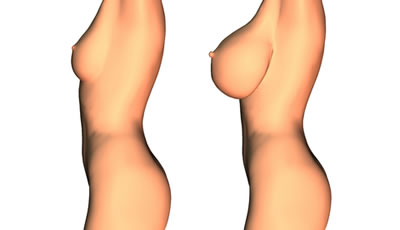Breast Augmentation (Breast Implants)
Breast enlargement surgery (breast augmentation or augmentation mammoplasty, تكبير الصدر) is a surgical procedure performed under local or general anaesthesia, which involves inserting breast implants (silicon or saline) to enlarge the breasts, modify their shape, or make them more even. Moreover, a boob job improves the breast contour and turns up the volume postpartum.[1]
A boob job is extremely popular and has been the number one cosmetic procedure in countries such as USA, UK, Australia, and Canada. An estimated 6 million women have breast implants in the USA as of 2011.[2]

Breast implants composition
A breast implant is an artificial body part (a prosthesis) used to change the volume, size, and contour of a woman’s breast, There are three common types of breast prosthesis, defined by their composition material:
- Silicone gel
- Saline solution in a silicon membrane
- Composite filler
Injectable liquid silicone oil and silicone gel in breast implants differ depending on the nature of the silicon oil used. The majority of plastic surgeons stopped doing silicon oil shots (injections), which is no longer a breast implant option, because the post-therapeutic results are unpredictable and not to forget the numerous possible side effects of using it. Common adverse reactions to silicon oil injections include:
- Extrusion
- Pores and skin necrosis
- Infection and immunity related problems
- Chronic recurrent locally destructive siliconomas
Women seeking boob jobs must not go through this risky procedure, because of the potential side effects especially that this process can cause deformity.
Approved breast implants are composed of material that is:
- Non toxic
- Non allergenic
- Non teratogenic
- Biocompatible to human tissue
All implants must have the capacity to adapt to human tissue and behold the forces applied to them, so that to reduce the potential risks and to make their outcomes more predictable. Augmentation mammoplasty is a self-explanatory procedure with immediate satisfying results, and because of this, the public’s attention and interest in it was at an all-time high. Moreover, it is the only procedure in plastic surgery that is 100% planned and based on both the patient’s choice and examination.
Few years back, and in the period between the late 70’s and early 80’s a big scandal associated with breast cancer cases in women having silicone gel-
There are two basic types of breast implants:
- Saline implant filled with sterile saline solution
- Silicone implant filled with viscous silicone gel
Breast implants are created of an external membrane made of hard silicone, which is filled by either saline (fluid) or silicon (cohesive gel) materials. It is advisable to tell the patients about the benefits and risks of each implant and allow them to make their decision before operating them.
Breast enlargement surgery is performed under local or general anaesthesia, and the process can be done as an outpatient surgical treatment (ambulatory surgery or same-day surgery) that is the patient can be admitted and sent home in the first or second postoperative days, depending on the surgeon.
Weather will certainly play a role as its known, hot weathers may provoke infections in the postoperative period, and in this case its preferred for the patient to stay at the hospital for a couple of days after surgery.
Nerveless, preoperative test results and healthcare clearance are actually required.
The operation takes between one and two hours, and Breast implants are inserted through a couple of incision options:[3]
- Axillary, or underarm approach.
- Areolar approach (peri-areolar incision).
- Inframammary, or breast fold approach.
Each type of incision has its advantages and side affects in terms of:
- Scar cosmesis, as scar-related issues in patients undergoing augmentation mammoplasty are not uncommon, and the impact of scar cosmesis perception on quality of life had been proven, for this a scarless approach where the cut is invisible and the breast is 100% looking natural is favorable.
- Nipple sensation, as women may lose the pleasure of touch after operation.
Among the three available incisions in augmentation, the transaxillary approach has the best scar cosmesis, because it is hidden as well as nipple sensation is nicely preserved.
Common postoperative augmentation complaints
- Pain
- Inflammation
- Mild bruising
Common postoperative Adverse Outcomes
- Chest wall deformity or if the underlying thoracic cage appears deformed.
- Extrusion or when the implant appears through the skin.
- Asymmetry breasts appear uneven in terms of size, shape, or breast level.
- Breast feeding difficulties.
- Hematoma.
- Implant displacement or malposition.
- Infection with a toxic shock syndrome.
- Nipple or breast changes.
- Seroma or the collection of fluid around the breast implant.[7]
- Breast tissue atrophy.
- Lymphedema or lymphadenopathy.
- Unsatisfactory appearance and scarring.
- Necrosis.
Symptoms may persist for several days after surgery; However, an acute psychotic episode due to transitive and physical changes can last longer.
Patients need to wear breast binders (post augmentation bras) for a period of three to six weeks. This can hold the breast implants in position during the recovery process. Moreover, it will reduce friction, pain and inflammation respectively.
Suture should be removed at 8-10 days postoperatively.[1][6]
Any woman planning to have a boob job done will need from 10 to 14 days for preliminary consultation, lab tests, prognostic evaluation, surgery, follow up, stitch removal, and early healing.
After this period the patient will make a full recovery.
References
Verified by: Dr.Diab (September 16, 2018)
Citation: Dr.Diab. (September 16, 2018). Breast Augmentation (Breast Implants). Medcoi Journal of Medicine, 22(2). urn:medcoi:article1232.













There are no comments yet
Or use one of these social networks